
Breaking News

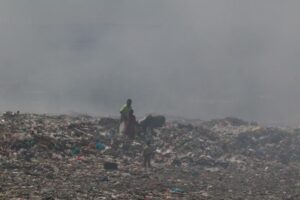
Africa, Climate Action, Conferences, Development & Aid, Environment, Featured, Headlines, Health, Sustainable Development Goals, TerraViva United Nations
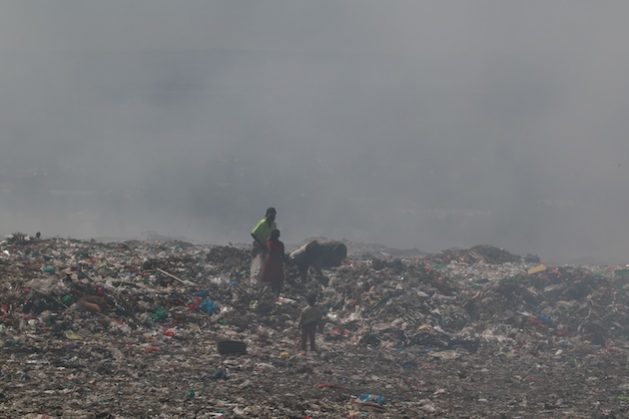
A mother and her children are seen wading through a cloud of smoke at the Dandora dumpsite, Kenya’s largest open landfill. Smoke emanating from the dumpsite is cited as a contributor to air pollution in Nairobi. Credit: Jackson Okata/IPS
– Deborah Adhiambo (43) has been battling mild asthma since 2022, a condition she describes as “both a health and economic burden.’’ The mother of three lives within Dandora Estate, nine miles east of Kenya’s capital, Nairobi. Dandora is home to Kenya’s largest open landfill, which receives more than 2,000 metric tonnes of waste daily.
For five years, Adhiambo operated a makeshift restaurant near the dumpsite, where her main clients were waste pickers working within its environs.
“Working near the dumpsite exposed me to the heavy smoke that billows from the dumpsite. I started developing chest pains gradually and would take painkillers to subdue the pain. It was later that I was diagnosed with asthma,’’ Adhiambo told IPS.
Adhiambo’s doctors told her that prolonged and constant exposure to toxic fumes was the root cause of her asthma. She was forced to close her business since she could not venture out of her house early in the morning, late in the evenings or during cold seasons.
“The closure of my business due to sickness crippled me economically as it was my only source of income. Getting medication and feeding my family has been hard because now I have to rely on my husband, who also works at the dumpsite,” she says.
Nairobi’s Air Quality
More than 70 percent of Nairobi’s 5.3 million residents live in informal settlements like Dandora, which analysts say have the worst air quality, with vulnerable populations, particularly women and children, bearing the brunt of polluted air. Vehicles, open burning of waste, and industrial emissions are cited as the major sources of air pollutants in Nairobi. Motor vehicles contribute an estimated 40 percent of Nairobi’s particulate matter (PM2.5) air pollution concentrations, with illegal dumping and open waste burning contributing 25 percent.
And as both the population and economic output of Kenya’s capital keep expanding, the demand for energy from fossil fuels is also on the rise. The rapid expansion of Nairobi has taken an environmental toll on the city, which is evident in the worsening air pollution levels. Air pollution in Kenya’s capital is 4.2 times higher than the World Health Organization’s (WHO) recommended average annual concentration levels.
According to the World Health Organization, Nairobi’s air pollution is 2.4 times higher than recommended levels, with 19,000 poor air quality deaths being reported in Kenya annually.
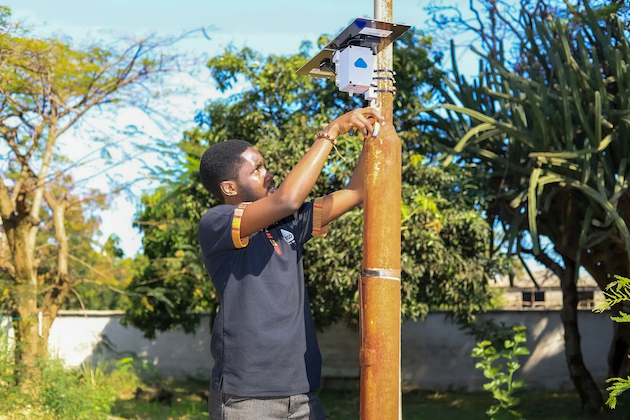
A technician installs a low-cost air quality monitor sensor in Nairobi, Kenya. Air quality monitors are helping Nairobi collect data on air pollution. Credit: Jackson Okata/IPS
Tech and Data
To enhance her efforts in combating air pollution, the City of Nairobi has been incorporating the use of technology. The city management has been installing low-cost air quality monitors and sensors to gather and share data on the levels of air pollution trends across the city. The data collected is then analyzed and guided in the formulation of policies and legal frameworks to combat air pollution, even as East Africa’s economic giant works towards realizing her ambitious target of becoming a net-zero green city by 2030.
Dubbed AirQo monitors, the low-cost air quality sensors developed by a team of young engineering and computer science students at Uganda’s Makerere University are in use in eight countries, including Kenya.
Engineer Bainomugisha, an Associate Professor of Computer Science at Makerere University and lead developer of the AirQo monitoring system, says Sub-Saharan Africa lacks usable air quality data that can help in the formulation of proper and effective policies to combat air pollution. AirQo monitors collect information about air pollution levels, types of air pollutants, and air quality
Bainomugisha explains that the air quality monitors main aim is to “close the existing gap in air quality monitoring.” AirQo air quality monitors collect air samples, which are then analyzed through a light scattering technology that quantifies the particulate matter concentration.
The information is then relayed to a cloud-based network that determines the pollution levels in a specific area. The devices measure the air particulate matter PM2.5 and PM10, which is a mixture of solid particles in the air. They also capture ambient meteorological conditions such as humidity and atmospheric pressure
“The air quality monitors run on a 2G GSM-enabled network configuration for loT sim cards and are optimized to work in areas with unstable internet and power connectivity,” says Gideon Lubisia, AirQo’s international operations embedded systems and network support engineer.
AirQo has also developed a mobile app that allows people to receive periodic and real-time updates on the air quality in their city. The monitors are mounted at strategic points within the city’s Central Business District, industrial areas, markets, along major city highways and in select residential areas. while others are mounted on motorbikes that move from one location to another, collecting data.
Data and Policy Formulation
With the monitors in place, Nairobi City has been able to develop two air quality collocation installations and infrastructure reference grade monitors, according to Nairobi City County Deputy Director in Charge of Air Quality and Climate Maurice Kavai.
“The one-stop center collocation enables our research teams to compare air quality data collected from various points within the city, which is key in developing appropriate action,” Kivai explained.
“The availability of periodic data collected by the monitors enables the city to establish the extent of pollution in particular areas, identify the causes, and develop necessary actions,” he said.
Through air quality data collected through the monitors and establishing the extent of air pollution in the city, Nairobi has been able to develop a city Air Quality Action Plan as well as enact the Nairobi City County Air Quality Act which have become critical policy and legal assets in tackling the problem of air pollution.
AirQo monitors are now in use within select cities in eight African countries, including Uganda, Kenya, Nigeria, Cameroon, Burundi, Ghana, Mozambique, and Senegal.
Global Push for Clean Air
During the Climate and Clean Air Conference(CCAC) 2024 in Nairobi between February 21 and 23, 2024, ahead of the sixth session of the UN Environment Assembly (UNEA-6), member states and partners launched a Clean Air Flagship effort to provide, among other things, data-led policy action towards combating air pollution
Inger Andersen, UNEP’s Executive Director, said, “We need to push harder on superpollutants. Just as you need a superhero to defeat a supervillain, we need super solutions to face down super pollutants. And we need you to mastermind these solutions.”
Speaking on the sidelines of the CCAC, Kenyan environmentalist Elizabeth Wathuti observed that “the very essence of life starts with a breath, a gasp of air that signifies the beginning of our journey on this Earth. Yet, for too many across our globe, this fundamental act of breathing has become a hazard, a risk, and a gamble against the odds of pollution and climate-induced adversities.” According to Wathuti, the commitment to clean air and a stable climate is not just an environmental cause but a fight for the very right to life.
The World Health Organization estimates that 99 percent of the world’s population lives in places with poor air quality, leading to nearly seven million premature deaths per year, primarily in low- and middle-income countries.
According to UNEP, in Africa alone, ambient air pollution caused an estimated 400,000 premature deaths in 2019, while indoor air pollution caused more than one million premature deaths in the same year. Some of the leading air pollution-related ailments that contribute to these premature deaths include pneumonia, heart disease, stroke, diabetes, chronic lung disease, and lung cancer. Ambient air pollution and household air pollution are associated with 6.7 million premature deaths annually.
IPS UN Bureau Report
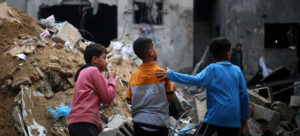
Armed Conflicts, Civil Society, Featured, Global Governance, Headlines, Human Rights, Middle East & North Africa, TerraViva United Nations
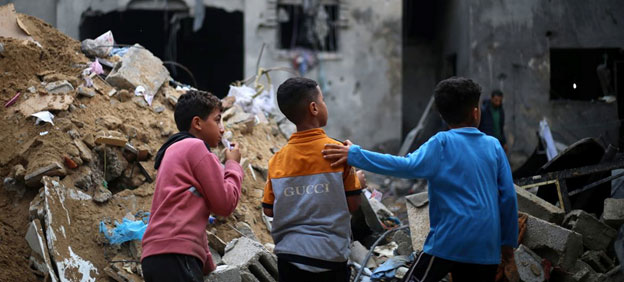
Children look at their destroyed homes in Rafah city, in the southern Gaza Strip. Credit: UNICEF/Eyad El Baba
– Nothing could prepare me for my recently concluded mission into the Gaza Strip, where children face catastrophic conditions.
In my twenty years with UNICEF, traveling from one humanitarian crisis to the next – from famines to floods and war zones to refugee camps – I’ve simply never seen such devastation and despair as is happening in Gaza.
The intensity of the attacks, the massive number of child casualties, the desperation and panic of the people on the move – people who already have nothing – is palpable. It is humanitarian disaster on top of humanitarian disaster.
Near the start of the recent brief pause in fighting, we set out early in the morning at Rafah on the border with Egypt. Our convoy of trucks carrying vital humanitarian aid made its way slowly in a punishing journey north to Gaza City, which hadn’t seen aid in weeks.
The two cities are just 35 kilometres apart, but travelling through a war zone always makes distances seem more daunting. Along the way, I saw apartment building after apartment building, home after home, flattened by the bombings, a dystopian scene that stretched for miles.
In Gaza City I got out to look more closely at a building that had been reduced to rubble. Inside, I noticed bloodstains, but it’s impossible to know whether the people who were pulled out of this mass of concrete survived.
I will never forget how a man in his 60s walked out from the ruins of a recently bombed apartment building. At first, I thought he was indicating the number 10, as in 10 people had been killed. But he corrected this, using a stick to write in the dirt: 30. It wasn’t the number of people killed. It was the number of his extended family members killed in the blast.
This man had lost everyone, his whole extended family, everyone he loved. At the start of this war, UNICEF said Gaza was a “graveyard for children and a living hell for everyone else.” It has only gotten worse as the bombing and fighting have continued.
There was a hope that the devastation seen before the pause would not be repeated should the fighting resume. But after hearing hundreds and hundreds of rounds of artillery and more explosions, I could tell that it’s happening.
Within hours, the humanitarian pause felt too long ago.
I walked across the wreckage of what I was told was once a tight-knit community that is now broken glass, rubble and steel crunching under my feet. Homes sliced open, their contents exposed like doll houses, the inside of lives laid bare.
Against the grey rubble, eerie remnants of normalcy cropped up, like a sofa on a third-floor apartment with no walls, or a painting on the only wall left standing after a blast.
I looked at what was once a child’s bedroom, with pink blankets, a cupboard, shelves full of books, fluffy stuffed toys. It looked like the room of any 12-year-old girl, from any middle-class family, anywhere in the world. It was largely untouched. The little girl would have been safe if she wasn’t in another room with her family when the home was struck.
Driving through Gaza there’s never much time for reflection. The aid convoy needs to keep moving.
Along the route we saw the same theme repeated in neighborhood after neighborhood: basic needs are not being met. People need water and nourishment. Hospitals need medicine. This convoy has all those things. But despite our efforts and those of our UN colleagues, I know it’s not enough. It’s not nearly enough.
As one of my UNICEF colleagues noted just a couple of weeks into the war, the killing and maiming of children, abduction of children, attacks on hospitals and schools, and the denial of humanitarian access are a stain on our collective conscience. It was true then, it remains true now.
From Gaza City we pushed further north, to Jabaliya. The first thing I noticed were the piles of rotting garbage outside hospitals, offices and schools. Sanitation and rubbish collection services have broken down completely, of course, as trucks have no fuel to collect it and the conflict has displaced most of the workers who do these jobs anyway.
One hospital we visited, Al-Ahli Arab Hospital, was utterly chaotic. It was overcrowded, loud, intense. Our trucks were delivering medical supplies while wounded people were being rushed in bleeding.
We eventually made it back to the south of Gaza, to what we call the Joint Operation Centre. That’s where dozens of UN workers meet to discuss the next mission. The mood was sombre. We all know what Palestinian families need: they need more of everything, especially medicines, water, fuel, food.
But genuine safety for Gaza’s children depends on parties to the conflict ensuring that humanitarians have unimpeded access to civilians wherever they are… on our ability to bring water, essential food, nutrition supplements, fuel and other humanitarian supplies into the territory… and on parties implementing an immediate humanitarian ceasefire.
Unless those conditions are met, children in Gaza are now in danger from the sky, disease on the ground, and death from hunger and thirst. Nowhere is safe.
The children of Gaza have suffered enough. We need a humanitarian ceasefire, and peace, now.
James Elder is UNICEF’s spokesperson. Follow him @1james_elder
Source: UNICEF BLOG
IPS UN Bureau